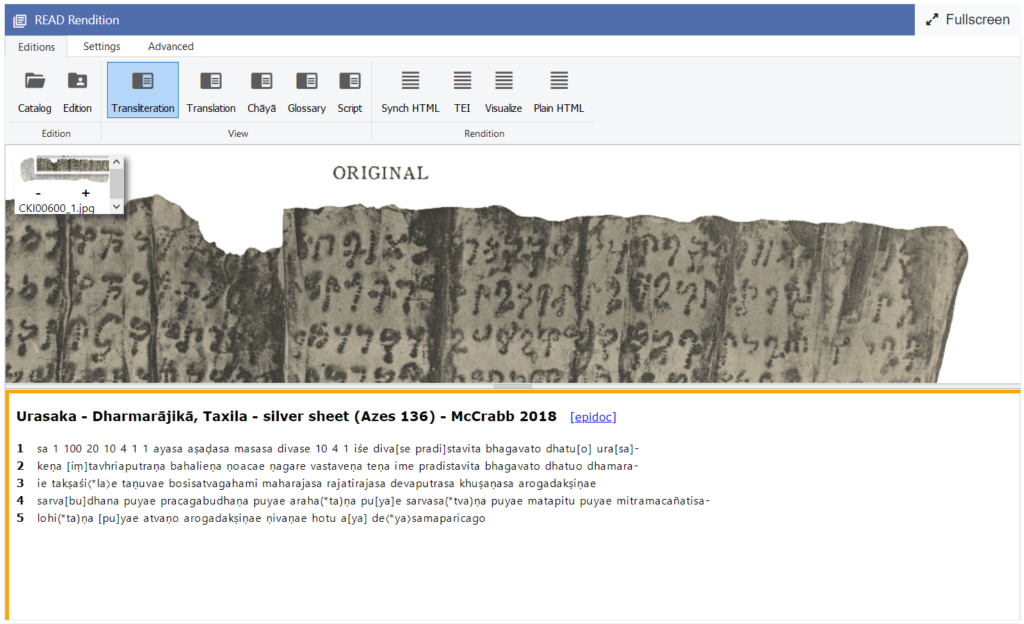This is the second text on scroll 20 of the Robert Senior collection. It is a Buddhist sūtra, or discourse attributed to the Buddha. I have reconstructed the Gāndhārī title *Mahaparaḍaha Sutra based on the name of the hell discussed in the text and the title given in the Burmese Pali parallel. Parallels, which are listed below, can be found in Sanskrit, Pali, and Chinese Saṃyuktāgama/Saṃyutta-nikāya collections. These collections, sometimes translated as “Connected Discourses,” consist of sūtras grouped according to themes, and make up one of the five major groups of early Buddhist sūtras. Given that at least twenty-six texts on the Robert Senior scrolls have parallels in collections of Connected Discourses, we can presume that the Gāndhārī Mahaparaḍaha Sutra was likely to also have been drawn from such a collection in Gāndhārī. In Pali and Chinese, the parallel discourses appear in a chapter on the topic of truth (Skt. satya).
Item Robert Senior Scroll 20 | Text 2 | Surface r.11 – v.30 | Material Birch Bark | Size H: 19.7 cm; W: 22.3 cm | Findspot uncertain (presumably Haḍḍa, Afghanistan) | Date approx. 140 CE | Current Location University of Washington, Seattle
Content Summary
In Śrāvastī, the Buddha teaches monks about a hell called “Great Conflagration,” where bodies burn like hot iron balls. When a monk asks if there is a worse conflagration, the Buddha replies that ignorance of the four noble truths leads one to generate formations (G. sakhara) that result in the conflagrations of birth, old age, disease, death, sorrow, lamentation, and turmoil.
Keywords
four noble truths, hell, saṃskāras
Parallels
- P. SN 56.43 at SN V 450-2 (Pariḷāho Sutta [Ee], Mahāpariḷāha Suttaṃ [Be])
- Ch. SĀ 422 at T II 111b10-24
- Skt. Sanskrit Turfan Fragment (SHT) II 51 f1t + 2 B1.[10]4
Previous Editions
-
Salomon, Richard, 2003, “The Senior Manuscripts: Another Collection of Gandhāran Buddhist Scrolls,” Journal of the American Oriental Society 123: 73-92.
(A preliminary study of lines 11-17).
-
Marino, Joseph, 2019, “From the Blacksmith’s Forge to the Fires of Hell: Eating the Red-Hot Iron Ball in Early Buddhist Literature,” Buddhist Studies Review 36/1: 31-51.
(Transliteration and translation of lines 13-15).
Acknowledgements
Research on this edition was completed with the generous support of the Dhammachai International Research Institute and the Robert H. N. Ho Family Foundation in Buddhist Studies
Digital publishing by Joe Marino and Ian McCrabb
Each digital edition includes background information about the text, a summary of its content, and references to parallel texts and related publications. Users can explore the text, image, and other analysis resources through various preset views from the READ interface, or customize the views themselves.
By developing the text in READ, the text and image are linked such that selecting a syllable, word, or compound in the text or glossary will highlight the associated akṣaras on the manuscript. This allows you to in effect “read” the manuscript as you read the transcribed text, even if you do not know the script.
Users can choose from several preset READ views by selecting the tabs at the top. Each of these convenient arrangements of text and resources is suited to a different experience with the manuscript. For instance, choose the Script view to study the paleography of the manuscript or the Glossary view to study its vocabulary. It is recommended that the user toggles through the default views to gain a holistic perspective of the text.

- Transliteration: Image and transliteration.
- Translation: Transliteration and translation.
- Chāyā: Transliteration and chāyā.
- Glossary: Image, transliteration, and glossary.
- Script: Image, transliteration, and script chart
- Visualize: Visualize the text structure display.
- Synch HTML: Interactive synchronized rendition.
- TEI: EpiDoc TEI rendition.
- Plain HTML: Transliteration in HTML format.
Avś
Be
Ce
Ch.
CPS
DhG
Ee
FJJ
Mahīś
MūSā
Mvu
P
SĀ
SBhV
Se
Skt.
SN
T
Tib.
Vin
Avadānaśataka (ed. Speyer 1906–1909)
Burmese (Chaṭṭhasaṅgāyana) edition
Sri Lankan (Buddha Jayanti Tipiṭaka Series) edition
Chinese
Catuṣpariṣat-sūtra (ed. Waldschmidt 1952–1962)
Dharmaguptaka
European (Pali Text Society) edition
Fobenxing ji jing (T 190)
Mahīśāsaka
Mūlasarvāstivāda
Mahāvastu-avadāna (ed. Senart 1882–1897)
Pali
Saṃyukta-āgama (T 99)
Saṅghabhedavastu (ed. Gnoli 1977–1978)
Thai (King of Siam) edition
Sanskrit
Saṃyutta-nikāya
Taishō 大正 edition
Tibetan
Vinaya
Cite this article as: Joe Marimo, “Mahaparaḍaha Sutra,” Journal of Gandhāran Buddhist Texts, December 21, 2020, https://gandhari-texts.sydney.edu.au/edition/mahapara%e1%b8%8daha-sutra

